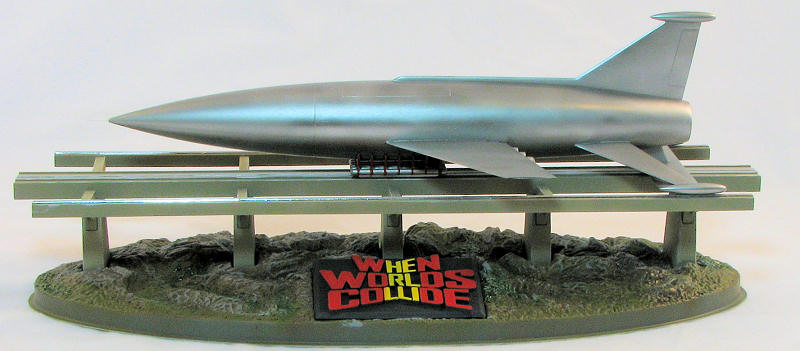
Pegasus Hobbies 1/350 'When Worlds Collide' Space Ark
| KIT #: | 9011 |
| PRICE: | $25.99 MSRP |
| DECALS: | None |
| REVIEWER: | Scott Van Aken |
| NOTES: | New mold kit |

| HISTORY |
When Worlds Collide is a 1951 science fiction film based on the 1933 novel co-written by Philip Gordon Wylie and Edwin Balmer. The film was shot in Technicolor, directed by Rudolph Maté and was the winner of the 1951 Academy Award for special effects.
Producer George Pal considered making a sequel based on the novel After Worlds Collide, but the box office failure of his 1955 Conquest of Space made it impossible.
Here is the plot:
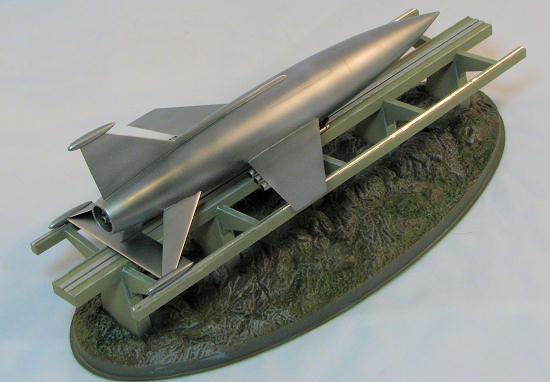 Pilot David Randall (Richard Derr) is paid to fly mysterious photographs from South African astronomer Dr. Emery Bronson (Hayden Rorke) to Dr. Cole Hendron (Larry Keating) in America. Hendron, with the assistance of his daughter Joyce (Barbara Rush), confirms their worst fears— Bronson has discovered a star named Bellus and it's on a collision course with Earth.
Pilot David Randall (Richard Derr) is paid to fly mysterious photographs from South African astronomer Dr. Emery Bronson (Hayden Rorke) to Dr. Cole Hendron (Larry Keating) in America. Hendron, with the assistance of his daughter Joyce (Barbara Rush), confirms their worst fears— Bronson has discovered a star named Bellus and it's on a collision course with Earth.
Hendron warns the delegates of the United Nations that the end of the world is little more than eight months away. He pleads for the construction of spaceships to transport a lucky few to Zyra, a planet in orbit around Bellus that will pass very close to the Earth, in the faint hope that it can sustain life and save the human race from extinction. However, other, equally-distinguished scientists scoff at his claims, and he is not believed. With no help from the United Nations or the United States government, Hendron receives help from wealthy humanitarian friends, who arrange a lease on a former proving ground to construct a spaceship. To finance the construction, Hendron's group is forced to turn to self-centered, wheelchair-using industrialist Sidney Stanton (John Hoyt). Stanton demands the right to select the passengers, but Hendron is able to convince him this is not necessary by offering him a seat.
Joyce becomes attracted to Randall and prods her father into finding reasons to keep him around, much to the annoyance of her boyfriend, medical doctor Tony Drake (Peter Hansen). The ship's construction is a race against time. Groups in other nations also begin building ships. Formerly-skeptical scientists admit that Hendron is right and governments prepare for the inevitable. Martial law is declared and residents in coastal regions are moved to inland cities.
Zyra first makes a close approach, its gravitational attraction causing massive earthquakes, volcanic eruptions, and tidal waves that wreak havoc. Several people are killed at the construction camp, including Dr. Bronson. In the aftermath, Drake and Randall travel by helicopter to provide assistance to survivors. When Randall alights to rescue a little boy, Drake has to resist a strong temptation to strand him.
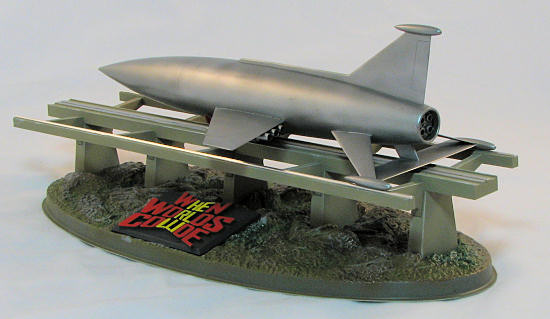 As the day of doom approaches, the ship is loaded with food, medicine, microfiche copies of books, equipment, and animals. Finally, most of the passengers are selected by lottery, though Hendron reserves seats for a handful of people: himself, Stanton, Joyce, Drake, pilot Dr. George Fry (Alden Chase), the young boy who was rescued, and Randall, for his daughter's sake. When a young man turns in his winning ticket because his girl was not selected, Hendron arranges for both to go. Randall refuses his seat and only pretends to participate in the lottery, believing that he has no useful skills. For Joyce's sake, Drake fabricates a "heart condition" for Fry, making a backup pilot necessary. Randall is the obvious choice.
As the day of doom approaches, the ship is loaded with food, medicine, microfiche copies of books, equipment, and animals. Finally, most of the passengers are selected by lottery, though Hendron reserves seats for a handful of people: himself, Stanton, Joyce, Drake, pilot Dr. George Fry (Alden Chase), the young boy who was rescued, and Randall, for his daughter's sake. When a young man turns in his winning ticket because his girl was not selected, Hendron arranges for both to go. Randall refuses his seat and only pretends to participate in the lottery, believing that he has no useful skills. For Joyce's sake, Drake fabricates a "heart condition" for Fry, making a backup pilot necessary. Randall is the obvious choice.
The cynical Stanton becomes increasingly anxious as time passes. Knowing human nature, he fears what the desperate lottery losers might do. As a precaution, he has stockpiled weapons. Stanton's fears prove accurate. His much-abused assistant, Ferris (Frank Cady), tries to get himself included in the crew at gunpoint, only to be shot dead by Stanton. During the final night, the selected passengers and animals are quietly moved to the launch pad to protect them from any more violence.
Shortly before takeoff, many of the lottery losers riot, taking up Stanton's weapons to try and force their way aboard. Hendron stays behind at the last moment, forcibly keeping the crippled Stanton and his wheelchair from boarding as well in order to lighten the spaceship. With an effort born of desperation, Stanton stands up and starts walking in a futile attempt to board the ship before it takes off.
From space, the ship's television monitor shows Earth's collision with Bellus. Hendron's sacrifice proves to be crucial, as the fuel runs out too soon and Randall glides the ship to an unpowered rough landing on Zyra. The passengers debark and find the planet to be hospitable. Remains of an alien civilization are also visible in the distance. David Randall and Joyce Hendron walk hand-in-hand to explore their new home.
| THE KIT |
Pegasus Hobbies is becoming more and more well known for producing nicely detailed kits that are as much a snap-tite as they are a 'standard' model kit. This means very large and very positive alignment pins/holes and not a lot of parts. It is this latter trait t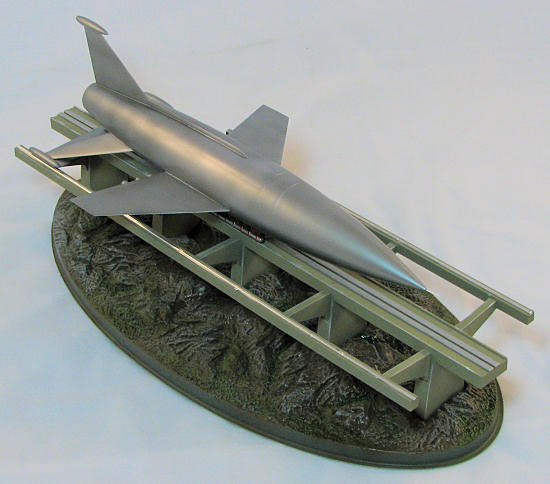 hat draws both young and old modelers. These are kits that can be built and enjoyed by modelers of all skill levels. If there might be a drawback, that would be the possibility of large seams, but previous kits have not really had much in the way of this trait as parts often fit quite snugly. I did find a few tiny dimples on the fuselage opposite alignment pins. You will also need to use Tamiya or other specific glues for this as it is made from ABS plastic and many of your standard cements will not work on it.
hat draws both young and old modelers. These are kits that can be built and enjoyed by modelers of all skill levels. If there might be a drawback, that would be the possibility of large seams, but previous kits have not really had much in the way of this trait as parts often fit quite snugly. I did find a few tiny dimples on the fuselage opposite alignment pins. You will also need to use Tamiya or other specific glues for this as it is made from ABS plastic and many of your standard cements will not work on it.
This one is no exception. There are minimal parts with the rocket taking the majority of bits. Two fuselage halves, wings, rocket pods/exhaust and a three piece tail plane takes care of the rocket. The launch sled is three pieces with the stand (consisting of a section of launch rail) taking up the other nine pieces. The base itself is a section of vacuformed ground into which the name plate fits. I'd be remiss if I didn't mention that there are no visible entrance hatches along the side as in the movie's rocket.
Instructions have six well drawn construction steps and a painting guide. Basically, a shiny metal rocket with a grey launch rail (probably a concrete color would work well for this). The model could probably be assembled without painting in about 15 minutes so it is perfect for kids. For your reviewer, adding the usual filler, sanding and painting will add about two weeks to the build! No decals, but then the 'real' one had no markings.
| CONSTRUCTION |
Thanks to the large and well formed parts, assembly got underway without any real problems. I first glued together the fuselage halves and installed the wings. Make sure that you install the rocket exhaust before putting together the fuselage or you'll never get it in place. I used filler on all the seams, including the ones where the wings fit as it should be rather seamless.
The rocket sled is just three pieces and after the usual clean-up, that was gl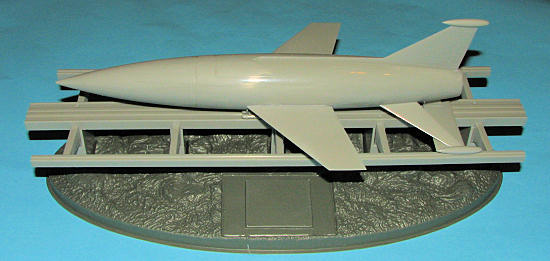 ued together. It will fit in holes on the launch ramp. The launch ramp is a single large construct with separate pylons that fit into the vacuformed base. I glued the pylons to the ramp structure and set this all into the base to be sure nothing was off kilter. The fit of the pylons is rather loose. There are gaps and it is up to the modeler whether these should be filled. I decided against it. The arms on the upper rail section have large peaked mold seams. I chose to remove these and after much scraping and sanding, got them to where they are a lot more flat.
ued together. It will fit in holes on the launch ramp. The launch ramp is a single large construct with separate pylons that fit into the vacuformed base. I glued the pylons to the ramp structure and set this all into the base to be sure nothing was off kilter. The fit of the pylons is rather loose. There are gaps and it is up to the modeler whether these should be filled. I decided against it. The arms on the upper rail section have large peaked mold seams. I chose to remove these and after much scraping and sanding, got them to where they are a lot more flat.
Back at the fuselage, I took care of round one of seam filling and attached the lower fins and wing. The attachment point on the outer pods is quite loose and again, I applied filler to this as well as the several depressed areas on the fuselage I found after sanding. Once that was done satisfactorily, it was time to hit the paint shop
| COLORS AND MARKINGS |
First thing I did was to primer the ark with gloss white. When it was dry, I sprayed it and the sled with Alclad II Dark Aluminum. This took a bit of paint as the ark is not a small rocket. Meanwhile, the launch rail assembly was painted Concrete using Floquil's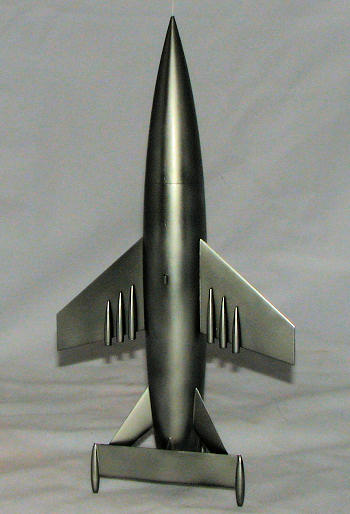 railroad enamels. Eventually, I used Bare Metal Foil chrome to cover the outer rails and I painted the broad inner ones with Citadel Mithril Silver.
railroad enamels. Eventually, I used Bare Metal Foil chrome to cover the outer rails and I painted the broad inner ones with Citadel Mithril Silver.
The vacuformed base was all brush painted. First with Aeromaster Dark Earth acrylics. Then some RAF Interior Green was painted in various areas, followed by some Humbrol #3 dark green. This was all set aside to dry. Actually, the painting went on over a considerable amount of time. This was one of those kits where I did a bit every once in a while during slow times on other projects. I also painted the name plate. It was first given a coat of Floquil Weathered Black enamels. When that was dry, I used Vallejo paints to first paint the lettering yellow (at least three coats) and then the outer sections red. Again, all of this was done using a flat brush.
Next, the sled had the uprights painted red using Testors Guards Red enamels. Back at the base, I drybrushed it all with a grey, using Vallejo acrylics. That toned down the difference in the various shades. I also dry brushed the launching rail sections with white on the edges, though I doubt it can be seen in the photos.
| FINAL BITS |
Actually, there aren't many. One was to glue the name plate on the vacuformed base. I used Gorilla super glue for this and for attaching the launching rails to the base. The sled was initially just pushed in place, but I later added some standard Tamiya glue to help hold it in place. The ark had the exhaust nozzles filled with Vallejo Black Grey. The pitot tube was glued in place and that was it. The ark isn't glued to the sled at this time, though I can see that I'll probably do so in the future.
| CONCLUSIONS |
Another very cool kit from Pegasus Hobbies. I'm a real sucker for stuff like this and it is doubly pleasing that the kit is well engineered. I'm hoping they will do other craft from various old sci-fi movies as there is a market out there for these things. If you have never built any of their kits, you owe yourself the treat of building them. Simple they are, but they are also satisfying constructs.
| REFERENCES |
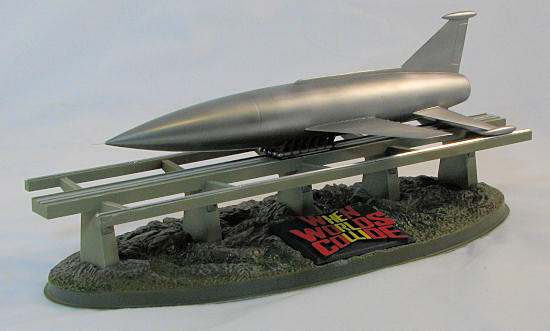 http://en.wikipedia.org/wiki/When_Worlds_Collide_%281951_film%29
http://en.wikipedia.org/wiki/When_Worlds_Collide_%281951_film%29
October 2010 Thanks to me for picking up this one. If you would like your product reviewed fairly and fairly quickly, please contact the editor or see other details in the Note to Contributors.